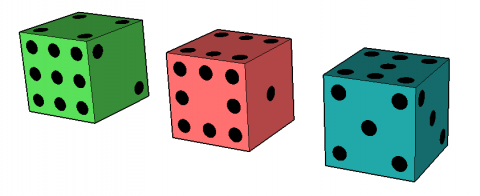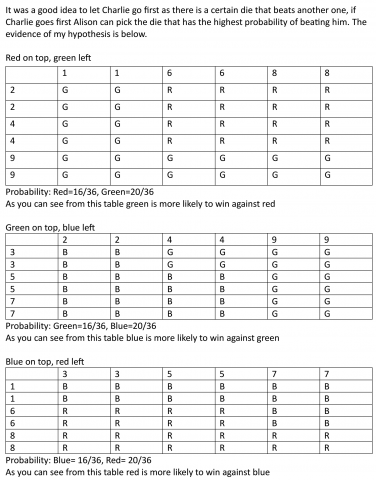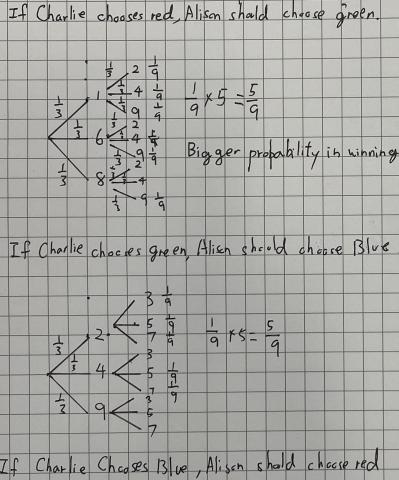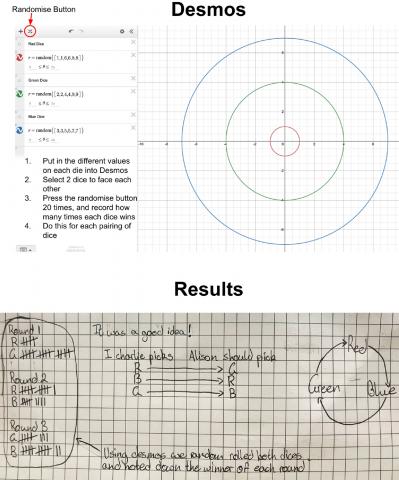Non-transitive dice
Alison and Charlie are playing a game. Charlie wants to go first so Alison lets him. Was that such a good idea?
Problem
Non-transitive Dice printable sheet
Here are three dice that are used to play a game for two players:

The red die has the numbers {1, 1, 6, 6, 8, 8}
The green die has the numbers {2, 2, 4, 4, 9, 9}
The blue die has the numbers {3, 3, 5, 5, 7, 7}
Each player chooses a different die.
They roll their dice.
The winner is the person whose die shows the bigger number.
Alison and Charlie are playing the game. Charlie wants to go first so Alison lets him.
Was that such a good idea?
Can you advise Alison on which die to choose once she knows which die Charlie has selected?
Notes and background
Dice of this sort are known as non-transitive dice. You can read more about transitivity in this article or have a go at creating your own in Dicey Dice. This spreadsheet might be useful if you want to create your own.
After you've had a go at the problem, you may be interested to read more about dice in the Plus articles Curious dice and Let 'em roll.
You may be familiar with another non-transitive game known as 'rock, paper, scissors'.
Getting Started
If Charlie picks the green die, what should Alison do?
If Charlie picks the red die, what should Alison do?
If Charlie picks the blue die, what should Alison do?
Student Solutions
We received lots of solutions to this problem with interesting strategies and ideas - well done to everyone who submitted one. Some people thought about which die Charlie is most likely to pick, and how Alison could respond. This is Johnny's work, from the British School Al Khubairat in the UAE:
So, I think that it was a bad idea for Charlie to go first, because he could pick the dice that had a 1/3 chance of being 9 (Dice B) or the dice that had a 1/3 chance of being 8 (Dice A) or the one that had a 1/3 chance of being 7(Dice C). If Charlie chose Dice B, he could potentially roll a 9, but he has a 66.6% chance of getting a much lower number. If he chooses Dice A, he has a 1 in 3 chance of rolling an 8, but again a 66.6% chance of rolling a lower number. He will probably go for Dice B, because of the high number possibility. If he does, Alison should go for Dice C, because if Charlie rolls a low number, she has a high chance of beating him, because she has 1/3 chance of 3, a 1/3 chance of 5 and a 1/3 chance of 7, which are all higher than the lowest possible number on Dice A and B.
Other people thought about what would happen with each pair of dice. For each pair, Nishtha from St Johns College Woodlawn in Australia compared the two lowest numbers, the two medium numbers and the two highest numbers. Will this always work?
Red die- To begin with, if Player 1 picks the red die (1, 1, 6, 6, 8, 8)
Player 2 can pick green (2, 2, 4, 4, 9, 9).
Overall, green has 2/3 chances of winning
Red- 1, 1, 6, 6, 8, 8 6, 6
Green- 2, 2, 4, 4, 9, 9, 2, 2, 9, 9
If player 1 picks green instead, player 2 can pick blue, as blue has a 2/3 chance or winning, and green is left with 1/3.
Blue- 3, 3, 5, 5, 7, 7 3, 3, 5, 5, (4 points or 2/3)
Green-2, 2, 4, 4, 9, 9 9, 9, (2 points or 1/3)
Finally, if player 1 picks the blue die, player 2 can pick the red die, in
order to get the chance of 2/3 to win, and leaving player 1 with 1/3,
making them less likely to win.
Blue 3, 3, 5, 5, 7, 7 3, 3, (2 points)
Red 1, 1, 6, 6, 8, 8 6, 6, 8, 8, (4 points)
Alice from NLCS in the UK considered which numbers 'beat' which other numbers in each pairing:
For each die, there is always another die which has a higher probability of obtaining a bigger number.
For example, in the red and green die, the red die’s 6 is bigger than the green die’s 2 and 4, and the 8 is bigger than 2 and 4 too, however the green die’s 2 is bigger than 1, 4 is bigger than 1, and 9 is bigger than 1, 6 and 8. So we have the red die has 4 different ways of obtaining a bigger number, but the green die has 5 different ways obtaining a bigger number, so the green die is more likely to win.
Egan from Marymount London and Yuhan from St George's British International School, Rome also counted how many ways each die could win in each pairing. Egan showed this as a table. Here is Egan's work:

Andrew from Kellet School in Hong Kong, Annabella from St George's British International School, Rome and Ci Hui Minh Ngoc Ong from Kelvin Grove State College Brisbane in Australia all used a similar idea, but expressed their work in probabilities on tree diagrams. Here is Andrew's work:

Lucas and Juan from Kellett School in Hong Kong also paired the dice up against each other, but then tried a very different approach. They simulated games between each pair of dice. They did these simulations in Desmos - randomised trials on Desmos. This is their work (click on the image to open a larger version):

Teachers' Resources
Why do this problem?
This problem offers a good opportunity to introduce or practise using sample space diagrams or tree diagrams. Transitivity is such a common phenomenon that most students take it for granted so they may be surprised and intrigued by the existence of non-transitive dice.
Possible approach
Before the lesson, create a set of the three dice from the problem.
When the volunteer has chosen one of the dice, choose the appropriate die from the two remaining. (Red beats blue, blue beats green and green beats red.)
Roll sufficiently many times for students to doubt whether this is a fair game!
"I seem to be lucky today, or perhaps my die is stronger than yours!"
"We're going to play the game again at the end of the lesson. I want you to explore whether you think the game is fair or not, and to work out a strategy for choosing dice that will give you the best chance of winning."
If it's not possible to make a set of dice before the lesson, you could introduce the task by asking students to work out how the game could be used to raise money at a school fundraiser, and what strategy the stallholders should use to fleece the public!
As students work on the task in small groups, circulate and observe the methods they are using. For those who have difficulty getting started you could use prompts such as:
"What are the possible outcomes when red plays green? What about when red plays blue? What about when green plays blue?"
"How could you organise the information systematically?"
"Are there any diagrams you could draw that might help?"
"How could you work out the probability of each of these outcomes?"
After a while, pause the class to share methods of approaching the task, and if appropriate introduce sample space diagrams or tree diagrams as a good organising structure for grouping the different possibilities. Then give them time to use the different methods to complete the task.
For those who finish early, challenge them to find other sets of non-transitive dice. This spreadsheet could be used to explore or to check.
Finally, bring the class together and invite them to challenge you to another game, using their strategy, and ask them to explain how they arrived at their conclusions.
Possible support
Tricky Track is a simpler context that can be used to introduce sample space diagrams or tree diagrams.
Possible extension
Dicey Dice invites students to create different sets of non-transitive dice, using the numbers from 1-6. Again, the spreadsheet could be used to consider different possibilities.
Further teacher guidance for this problem has been developed in collaboration with teachers by researchers at University of Oxford for the Developing Communication Responsive Mathematics Classrooms Project.
